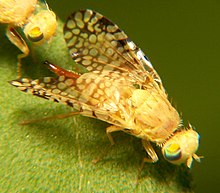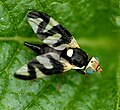Tephritidae
| Tephritidae | |
|---|---|

| |
| Euaresta aequalis | |
| Scientific classification | |
| Domain: | Eukaryota |
| Kingdom: | Animalia |
| Phylum: | Arthropoda |
| Class: | Insecta |
| Order: | Diptera |
| Section: | Schizophora |
| Subsection: | Acalyptratae |
| Superfamily: | Tephritoidea |
| Family: | Tephritidae Newman, 1834 |
| Subfamilies | |
| Diversity | |
| 500 genera, about 5,000 species | |
The Tephritidae are one of two
Description
For terms see Morphology of Diptera and Tephritidae glossary

Tephritids are small to medium-sized (2.5–10 mm) flies that are often colourful, and usually with pictured wings, the subcostal vein curving forward at a right angle. The head is hemispherical and usually short. The face is vertical or retreating and the frons is broad. Ocelli and cellar bristles are present. The postvertical bristles are parallel to divergent. Two to eight pairs of frontal bristles are seen (at least one but usually several lower pairs curving inwards and at least one of the upper pairs curving backwards). In some species, the frontal bristles are inserted on a raised tubercle. Interfrontal setulae are usually absent or represented by one or two tiny setulae near the lunula. True vibrissae are absent, but several genera have strong bristles near the vibrissal angle. The wings usually have yellow, brown, or black markings or are dark-coloured with lighter markings. In a few species, the wings are clear. The costa has both a humeral and a subcostal break. The apical part of the subcostal is usually indistinct or even transparent and at about a right angle with respect to the basal part. Crossvein BM-Cu is present; the cell cup (posterior cubital cell or anal cell) is closed and nearly always narrowing to an acute angle. It is closed by a geniculated vein (CuA2). The CuA2 vein is rarely straight or convex. The tibiae lack a dorsal preapical bristle. The female has an oviscape. [1]
The larva is amphipneustic (having only the anterior and posterior pairs of spiracle). The body varies from white to yellowish or brown. The posterior end of pale-coloured species is sometimes black. The body tapers at the anterior. The two mandibles sometimes have teeth along the ventral margin. The antennomaxillary lobes at each side of the mandibles have several transverse oral ridges or short laminae directed posteriorly. The anterior spiracles (prothoracic spiracles) end bluntly and are not elongated. Each has at least three openings or up to 50 arranged transversely in one to three groups or irregularly. Each posterior spiracle (anal spiracle) lacks a clearly defined peritreme and each has three spiracular openings (in mature larvae). These are usually more or less horizontal, parallel and usually bear branched spiracular hairs in four tufts.[2][3]
Ecology
The larvae of almost all Tephritidae are
The
Adult tephritid fruit flies are often found on the host plant and feeding on pollen, nectar, rotting plant debris, or honeydew.
Natural enemies include parasitoid wasps of the genera Diapriidae and Braconidae.
Economic importance
Tephritid fruit flies are of major economic importance in
Some fruit flies are used as agents of biological control, thereby reducing the populations of pest species. Several species of the genus Urophora are used as control agents against rangeland-destroying noxious weeds such as starthistles and knapweeds, but their effectiveness is questionable.[5] Urophora sirunaseva produces larvae that pupate within a woody gall within the flower and disrupt seed production.[6] Chaetorellia acrolophi is an effective biocontrol agent against knapweeds Chaetorellia australis and Chaetorellia succinea, deposit eggs into the starthistle seedheads, where their larvae consume the seeds and flower ovaries.[7]
Since economically important tephritid fruit flies exist worldwide, vast networks of researchers, several international symposia, and intensive activities on various subjects extend from ecology to molecular biology (Tephritid Workers Database).
Pest management techniques applied to tephritid include the use of cover sprays with conventional
Systematics
Tephritidae is divided into several subfamilies:[8]
- Blepharoneurinae (5 genera, 34 species)
- Dacinae (41 genera, 1066 species)
- Phytalmiinae (95 genera, 331 species)
- Tachiniscinae (8 genera, 18 species)
- Tephritinae (211 genera, 1859 species)
- Trypetinae (118 genera, 1012 species)
The genera Oxyphora, Pseudorellia, and Stylia comprise 32 species, and are not included in any subfamily (incertae sedis).
Identification
- Richard H. Foote, P. L. Blanc, Allen L. Norrbom, 1993 Handbook of the Fruit Flies (Diptera: Tephritidae) of America North of Mexico Cornell University Press (Comstock Publishing).
- Merz, B. 1994. Diptera Tephritidae. Insecta Helvetica Fauna 10: 1-198.
- White, I.M. 1988. Tephritid flies. Diptera: Tephritidae. [9]
- White I.M. & Elson-Harris M.M. 1994 Fruit Flies of Economic Significance: their Identification and Bionomics. 2nd ed. International Institute of Entomology, London.
- R.A.I. Drew and Meredith C Romig Tropical Fruit Flies of South-East Asia (Tephritidae: Dacinae) CABI ISBN 9781780640358
- Hendel1914. Die Gattungen der Bohrfliegen. Wein. Entomol. Ztg. 33: 73–98. Keys to World genera Out of date but still the only world monograph.
- Hendel, F., 1927. Trypetidae.In: Lindner, E. (Ed.). Die Fliegen der Paläarktischen Region 5, 49, 1-221. Keys to Palaearctic species but now needs revision (in German).
- Séguy, E. (1934) Diptères: Brachycères. II. Muscidae acalypterae, Scatophagidae. Paris: Éditions Faune de France 28. virtuelle numérique
- Rikhter, V.A. Family Conopidae in Bei-Bienko, G. Ya, 1988 Keys to the insects of the European Part of the USSR Volume 5 (Diptera) Part 2 English edition. Keys to Palaearctic species but now needs revision.
Species lists
- West Palaearctic including Russia
- Australasian/Oceanian
- Nearctic
- Japan Archived 2019-05-27 at the Wayback Machine
- World list
Gallery
-
Urophora cardui, male
-
Cheatostomella cylindrica
-
Eurosta solidaginis, gall maker on goldenrod
-
Gall of Procecidochares atra on Solidago
-
Eurosta solidaginis, female
References
- ISBN 0-901546-68-2.[citation needed]
- ^ K. G. V. Smith, 1989 An introduction to the immature stages of British Flies. Diptera Larvae, with notes on eggs, puparia and pupae.Handbooks for the Identification of British Insects Vol 10 Part 14. pdf Archived 2014-02-09 at the Wayback Machine download manual (two parts Main text and figures index)
- ^ Phillips, V.T., 1946. The biology and identification of trypetid larvae (Diptera: Trypetidae). Memoirs of the American Entomological Society 12: 1-161.
- ISSN 0003-4746.
- PMID 18767624.
- ^ Sobhian, R. 1993. Life history and host specificity of Urophora sirunaseva (Herng)(Dipt., Tephritidae), an agent for biological control of yellow starthistle, with remarks on the host plant. J. Appl. Entomol. 116: 381-390.
- ^ Turner, C.E., G.L. Piper and E.M. Coombs. 1996. Chaetorellia australis (Diptera: Tephritidae) for biological control of yellow starthistle, Centaurea solstitialis (Compositae), in the western USA: establishment and seed destruction. Bull. Entomol. Res. 86: 1 77-182.
- ^ Allen L. Norrbom (April 30, 2004). "Fruit Fly (Diptera: Tephritidae) Phylogeny". The Diptera Site. Agricultural Research Service. Archived from the original on July 9, 2010. Retrieved July 31, 2010.
- ISBN 0-901546-68-2.
Further reading
- Christenson, L. D. and Foote, R.H. 1960. Biology of fruit flies, Annu. Rev. Entomol., vol. 5, pp. 171–192.
- Bruce A. McPheron, Gary J. Steck (Editors), 1996 Fruit fly pests : a world assessment of their biology and management International Symposium on Fruit Flies of Economic Importance (4th : 1994 : Sand Key, Florida, USA) Delray Beach, Fla. : St Lucie Press
- Foote R.H., Steyskal G.C. 1981 Tephritidae. in: McAlpine J.F. (Ed.), Manual of Nearctic Diptera. Agriculture Canada, Ottawa, pp. 817–831.ISBN 0660107317 pdfdownload manual
- Pest Information Wiki
External links
- General
- Natural Enemies of True Fruit Flies (Tephritidae) Archived 2010-07-10 at the USDA
- Tephritidae Information from the Diptera Site
- Tephritid Workers Database
- Identification
- The Diptera site Comprehensive guide to identification literature with a worldwide perspective.
- Galleries
- Diptera.info images
- Images at BugGuide
- Family Tephritidae at EOL Image Gallery
- Control
- IPC-Fruit Flies webpage Archived 2015-01-10 at the Wayback Machine
- Pest Fruit Flies of the World Archived 2018-04-15 at the Wayback Machine
- Biological Control of Tephritidae











